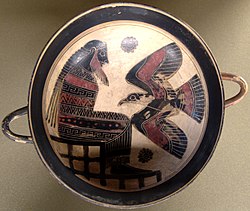Helot
| Sparta |
 Zeus on his throne with his eagle This article is part of the series: |
|
Great Rhetra Laws of Lycurgus Politeia |
|---|
|
List of Kings of Sparta Gerousia Ephorate Apella of the Damos Spartiates Perioeci Helots Agoge Syssitia |
|
Spartan army • Other Greek city-states • |
This article is part of the series:
Spartan Constitution
The helots (/ˈhɛləts, ˈhiːləts/; Ancient Greek: εἵλωτες, heílotes) were a population group that formed the main population of Laconia and Messenia, the territory controlled by Sparta. Their exact status was already disputed in antiquity: according to Critias, they were "slaves to the utmost", whereas according to Pollux, they occupied a status "between free men and slaves". Tied to the land, they primarily worked in agriculture as a majority and economically supported the Spartan citizens.
The number of helots in relation to Spartan citizens varied throughout the history of the Spartan state; according to Herodotus, there were seven helots for each Spartan at the time of the Battle of Plataea in 479 BC. Thus the need to keep helot population in check and prevent rebellion was one of the main concerns of the Spartans. Helots were ritually mistreated, humiliated and even slaughtered: every autumn the Spartans would declare war on the helots so they could be killed by a member of the Crypteia without fear of repercussion. Uprisings and attempts to improve the lot of the helots did occur, such as the Conspiracy of Cinadon.
...
Wikipedia
